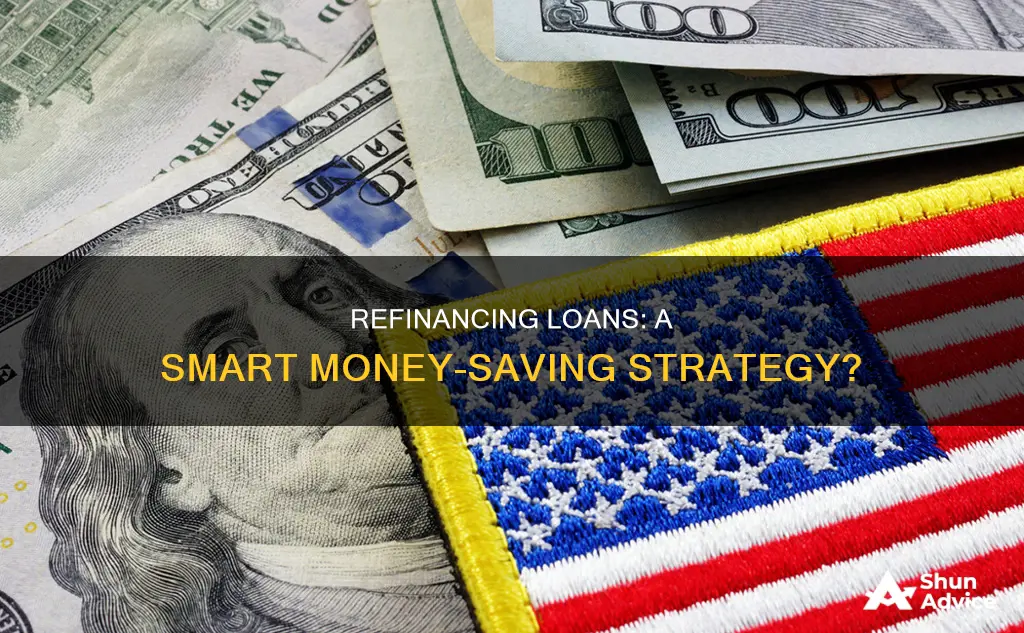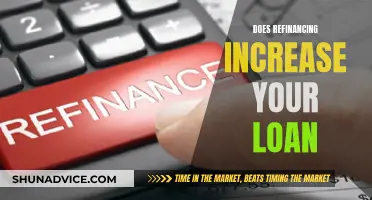
Refinancing a loan can be a great way to lower the cost of a mortgage when interest rates fall. It involves revising and replacing the terms of an existing credit agreement, usually relating to a loan or mortgage. Refinancing is typically done to take advantage of lower interest rates or improve the loan terms, such as the monthly payment or length of the loan. Consumers generally seek to refinance to obtain more favourable borrowing terms, often in response to shifting economic conditions. There are many types of refinancing, each with pros and cons, and it's important to consider the potential savings and costs before deciding whether it is the right move.
| Characteristics | Values |
|---|---|
| Definition | Refinancing refers to revising and replacing the terms of an existing credit agreement, usually relating to a loan or mortgage |
| Purpose | To take advantage of lower interest rates, improve loan terms, or obtain more favourable borrowing terms |
| Types | Cash-in refinance, no-closing-cost refinance, short refinance, reverse mortgage refinance, rate-and-term refinance |
| Benefits | Lower interest rates, reduced monthly payments, improved credit profile, debt consolidation, lower overall debt burden |
| Considerations | Compare refinance offers, costs, and savings; check credit score and history; consider prepayment penalties and origination fees |
| Process | Approach a lender, complete a new loan application, provide necessary documents, undergo credit check and financial evaluation |
What You'll Learn

Refinancing can help you get a lower interest rate
Refinancing a loan or mortgage is a great way to lower the interest rate, which can help borrowers save money. It involves replacing an existing loan with a new one with better terms, such as a lower interest rate, a smaller amount borrowed, or a shorter loan term.
When interest rates fall, refinancing can be a good option to reduce the cost of a mortgage. This is because a lower interest rate will save you money in the short and long term while reducing your monthly payments. For example, if you have a $400,000 loan and your interest rate is reduced from 7.25% to 6.75%, you can save about $134 per month.
There are different types of refinancing options available. A cash-in refinance involves making a lump sum payment to reduce your loan-to-value (LTV) ratio, which can help you qualify for a lower interest rate and lower your overall debt burden. A no-closing-cost refinance is a low-cost option that does not require upfront closing costs but may result in a higher interest rate. Rate-and-term refinancing allows you to switch from an adjustable-rate to a fixed-rate loan or vice versa, providing protection from future rate hikes.
Before refinancing, it is important to consider the costs involved, such as closing costs and application fees, and whether you will end up saving money in the long run. You should also shop around for the best refinance offer and compare it to your current loan terms. Additionally, maintaining a good credit score can help you qualify for a lower interest rate.
Quicken Loans: Hard Inquiry or Soft Check?
You may want to see also

It can also help you pay off your existing debts
Refinancing a loan can help you pay off your existing debts by consolidating them into one low-priced loan. This is a common goal for borrowers, especially those with high-interest credit card debt.
A rate-and-term refinance involves taking out a new loan with a lower interest rate and using it to pay off your existing debt. The new loan will have a lower monthly payment, providing you with extra cash to put towards your other debts. However, the principal balance remains the same, and you may end up paying more interest over the life of the loan.
A cash-out refinance is another option for consolidating debt. This involves taking out a new mortgage that is larger than your remaining balance, and using the difference to pay off your other debts. The bulk of the new loan will be used to pay off your old mortgage, and you will receive the remainder in cash. This option can provide a lump sum of cash to put towards high-interest debts, but it will increase your monthly mortgage payments and the overall cost of your loan.
Before refinancing, it is important to consider the costs, which can be significant. Fees can amount to between 2% and 7% of the loan's principal, and there may also be a prepayment penalty for paying off your old loan early. It is also important to evaluate your financial circumstances, including your credit score, debt-to-income ratio, and the amount of equity you have in your home.
Prosper Loans: Phone App Availability and Functionality
You may want to see also

You can refinance a mortgage, car loan, or student loan
Refinancing a loan means revising and replacing the terms of an existing credit agreement, usually relating to a loan or mortgage. It involves re-evaluating an individual's credit terms and financial situation. Refinancing can be a great way to lower the interest rates on your loans and improve the loan terms, such as the monthly payment or length of the loan.
Refinancing a Mortgage
Homeowners can refinance their mortgages to lower their costs when interest rates fall. The two primary options for refinancing a mortgage are a no cash-out refinance and a cash-out refinance. A no cash-out refinance involves refinancing the remaining unpaid balance on your mortgage and may be a good option if you want to lower your mortgage rate or switch to a different mortgage product. On the other hand, a cash-out refinance may be a good option if you've built up significant equity in your home and need funds for home improvements.
Refinancing a Car Loan
Refinancing a car loan can help lower your monthly car payments and provide financial flexibility. It can also help you pay off your loan sooner and save money on interest. However, refinancing a car loan with negative equity can be challenging unless you have good credit.
Refinancing a Student Loan
Refinancing student loans can help you lower your monthly payments, pay off your debt faster, and reduce the total interest paid over the life of the loan. It is a good option for those with private student loans, good credit, and stable incomes. Additionally, refinancing student loans does not carry any fees or costs.
Purchasing Power: Loans and Employee Benefits
You may want to see also

It can help you avoid prepayment penalties
Refinancing a loan or mortgage is a great way to take advantage of lower interest rates or improve the loan terms, such as the monthly payment or length of the loan. However, refinancing may trigger a prepayment penalty, which is a fee designed to discourage borrowers from settling a loan early, long before the term ends.
A prepayment penalty is a fee some lenders charge when you pay all or part of your loan off early. It is important to note that not all lenders charge prepayment penalties, and there are ways to avoid or minimize this penalty. Firstly, before choosing a mortgage, confirm whether the contract includes a prepayment penalty clause. Some lenders, like Rocket Mortgage, do not charge prepayment penalties. Secondly, if a prepayment penalty is attached to your mortgage, you can ask to have it removed or negotiate a lower fee.
Additionally, making a few extra payments towards your principal or paying a little extra each month usually won't trigger a prepayment penalty. However, if the extra payments exceed 20% of your loan balance in a given year, a prepayment penalty may be applied. Finally, if you are considering refinancing, it is essential to compare the potential savings of refinancing with the potential costs, including any prepayment penalties. By considering these factors, you can make an informed decision about whether refinancing is the right choice for you.
PSECU ATV Loans: What You Need to Know
You may want to see also

Refinancing can help you get a better rate by opting to lock for a shorter period
Refinancing a loan or mortgage is a great way to lower the cost of a mortgage when interest rates fall. It involves replacing an existing loan with a new one with improved terms, such as a lower interest rate, a different amount borrowed, or a different length.
Refinancing can help you get a better rate by opting for a shorter period. Lenders tend to offer lower rates on shorter-term loans because they are taking on less risk. The quicker you repay the loan, the less time there is for something to go wrong, like a market downturn or the borrower's financial instability. A lower interest rate can help you save money over time.
For example, refinancing from a 30-year loan at a 6.5% interest rate to a 15-year loan at a 6% interest rate can result in significant interest savings over the life of the loan. In this scenario, the total interest saved amounts to $226,950.78. While the monthly payments might be higher, a larger portion of these payments goes towards reducing the principal rather than just covering the interest.
However, it's important to consider the potential drawbacks of refinancing to a shorter-term loan. Shorter loan terms may be considered lower risk for lenders and investors, but they may represent a higher risk for homeowners based on month-to-month affordability. If you shorten the term of your mortgage, you will have a shorter timeframe to pay off the loan, which means larger monthly payments. This could be a significant financial burden for those who can't afford a higher monthly payment or have tight budgets or fluctuating incomes.
Private Loan Greenpath: A Smart Financial Move?
You may want to see also
Frequently asked questions
Refinancing, or refi, refers to revising and replacing the terms of an existing credit agreement, usually relating to a loan or mortgage. Refinancing a loan or mortgage is typically done to take advantage of lower interest rates or improve the loan terms, such as the monthly payment or length of the loan.
Refinancing can help borrowers take advantage of lower interest rates, which can lead to substantial savings on the total cost of the loan. It can also help to improve other loan terms, such as the monthly payment amount or the length of the loan. Additionally, refinancing can help consolidate debt, finance a large purchase, or invest in other opportunities.
When considering refinancing, it is important to compare the potential savings with the costs involved. It is also crucial to regularly check your credit score and be aware of your financial situation, as this can impact the approval of your refinancing application. Additionally, you may want to consider the length of time you plan to stay in your current home, as refinancing may not be the best option if you are not planning to stay for the long term.







